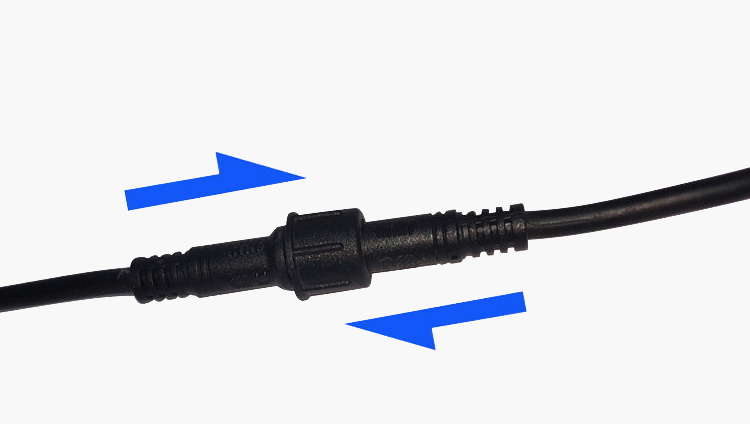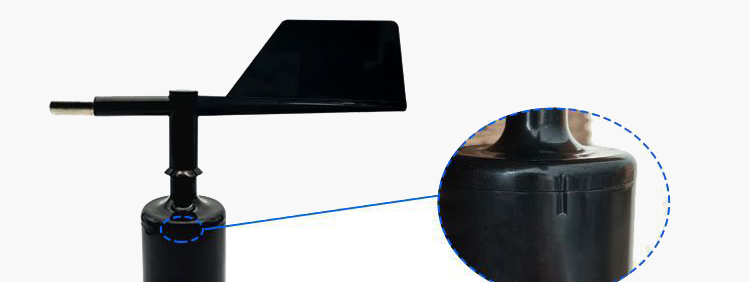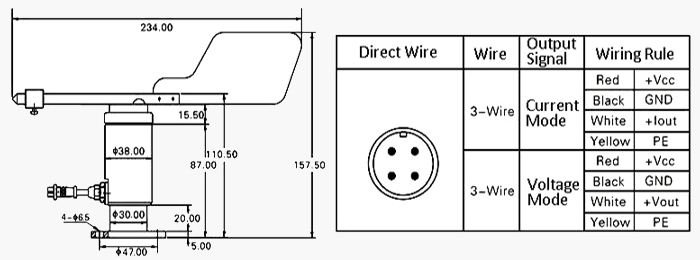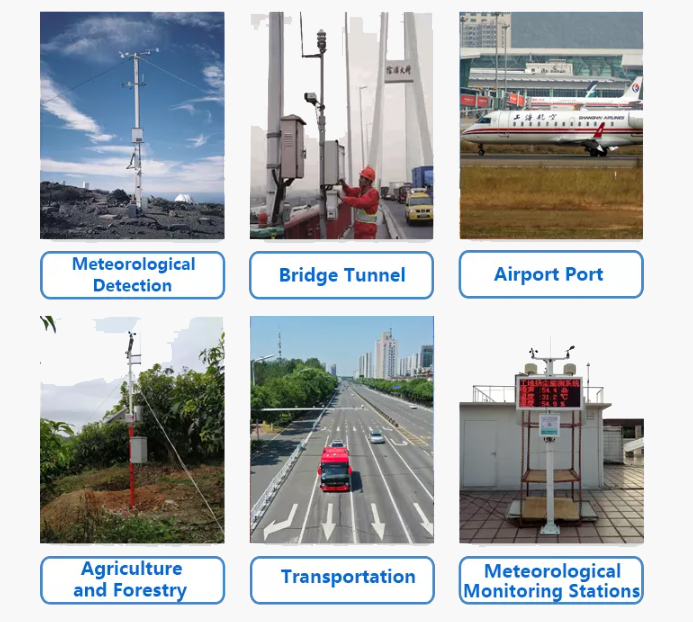Wind direction anemometer with the accuracy of information acquisition is ensured by matching with the internal smooth bearing system. The anemometer for wind direction is easy to observe in wide directions, convenient and stable, and widely used for wind measurement in greenhouses, environmental protection, weather stations, ships, docks, aquaculture, and other environments.

Waterproof butt plug cable Cable design
- Waterproof butt plug cable design, easy to connect, to avoid cable misconnection.
- Accuracy of information acquisition is ensured by matching with internal smooth bearing system.

Thoughtful pointing north prompt installation
- Installation of the illustrated position pointing due north, so as not to cause measurement errors
- The housing is made of ASA material, which has good anti-corrosion and anti-erosion properties.
Dimension & Wiring (Unit: mm)

Application
The thermal anemometer with 0~360° measuring range can measure wind direction, which widely used for meteorological detection, bridge tunnel, airport, agriculture and forestry, transportation and meteorological monitoring station, wind measurement in greenhouses, environmental protection, weather stations, ships, docks, aquaculture, and other environments.

| Model | SISICO-BRW200-2001 |
| Working voltage | 12-30V DC |
| Signal Output | RS485 |
| Measuring Object | Wind Direction |
| Measuring Range | 0~360° |
| Accuracy | ±3° |
| Start-up Wind Speed | ≤0.5m/S |
| Extreme Wind Speed | >70m/S 30min |
| Direction | 16 |
| Resolution Ratio | 22.5° |
| Working Temperature | -20℃~+85℃, Humidity :0~95% (not condensing) |
| Electrostatic Protection | 15KV |
| Surge Protection | EMC Ⅲ level |
| Protection Grade | IP65 |
| Dimension | 234mm*157.5mm |
| Weight | 0.5kg |
Q1: How do you ensure accuracy of anemometer?
A1: To make sure anemometers are reliable and precise, they should be regularly calibrated. This is the procedure of checking the accuracy of a measuring instrument – as well as the adjustment to align it with the standard. The process allows equipment to produce more accurate results than would've otherwise been possible.
Q2: What affects an anemometer?
A2: The higher the wind speed, the more power is required to keep the wire at a constant temperature. Wind speed can also be determined by measuring air pressure. (Air pressure itself is measured by an instrument called a barometer.) A tube anemometer uses air pressure to determine the wind pressure, or speed.
Q3: Does an anemometer measure wind direction?
A3: An anemometer looks like a weather vane, but instead of measuring which direction the wind is blowing with pointers, it has four cups so that it can more accurately measure wind speed. Each cup is attached to the end of a horizontal arm, each of which is mounted on a central axis, like spokes on a wheel.
Tips: How does an anemometer measure direction?
Anemometers measure wind speed by the amount of wind pressure against a surface, such as a cup or a propeller, or by using sonic pulses. A mechanical anemometer contains a wheel with cups or a propeller at the end of the spokes of the wheel.
Thank you for buying industrial test and measurement equipment on SISCO.com, all products sold by SISCO and the partner cover a 12 months warranty, effective from the date of receiving the products.
What is covered?
SISCO is responsible for providing free spare parts, and free technical support to assist the customer to repair the defective products until the problem is solved.
What is not covered?
- Product purchased from anyone other than a SISCO store or a SISCO authorized reseller.
- Expendable parts.
- Routine cleaning or normal cosmetic and mechanical wear.
- Damage from misuse, abuse or neglect.
- Damage from use of parts other than SISCO approved.
- Damage from use outside the product’s usage or storage parameters.
- Damage from use of parts not sold by SISCO.
- Damage from modification or incorporation into other products.
- Damage from repair or replacement of warranted parts by a service provider other than a SISCO authorized service provider.
- Damage caused by the application environment not meeting the product usage requirements and the failure to perform preventive maintenance.

